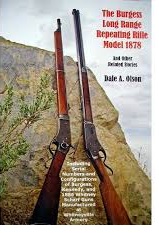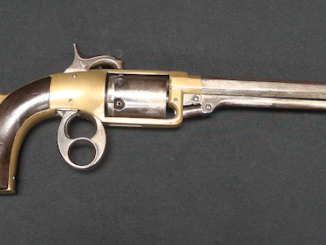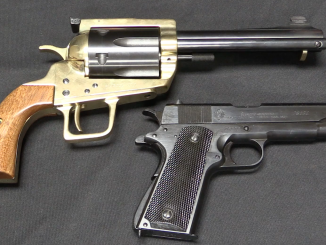 I’ve been getting curious to learn more about Andrew Burgess and his seldom-recognized guns, and took a look to see what books might be available on the subject. As it turns out, there are basically only two – one is readily available and inexpensive, and the other is out of print and costs more than I would like to spend on a book I have not been able to leaf through already.
I’ve been getting curious to learn more about Andrew Burgess and his seldom-recognized guns, and took a look to see what books might be available on the subject. As it turns out, there are basically only two – one is readily available and inexpensive, and the other is out of print and costs more than I would like to spend on a book I have not been able to leaf through already.
The available volume is Dale Olson’s The Burgess Long Range Repeating Rifle Model 1878 and Other Related Stories, published just a few years ago in (appropriately) Wyoming. For the price, it is a good reference, although I suspect the unavailable book (Samuel Maxwell’s Lever Action Magazine Rifles, Derived from the Patents of Andrew Burgess) would have significantly more technical detail. This is a review of Olson’s book, but I think it is important to put it in the appropriate context. Olson’s work is approximately 160 pages long, and half of that space is used to list the serial numbers and primarily characteristics of the known surviving examples of Burgess, Kennedy, and Scharf rifles. The remaining 80 pages include biographies of Andrew Burgess, Eli Whitney, and Eli Whitney Jr. (Whitney’s factory produced Burgess rifles in several forms), a developmental history of the Burgess 1878, a brief history of the Burgess Gun Company, and anecdotes of interesting individual Burgess rifles. The most detailed of these is an extended story of a frontiersman named W.F. “Bear” Davis, who was particularly known for an incident which left his Burgess rifle with teeth marks in the forearm, Davis with a bitten hand, and a bear shot thoroughly dead.
While I wish that the book were longer, I must say that Olson did a pretty good job balancing his content between the technical, the historical, and the cultural. There is enough mechanical detail here to inform the gunsmithing types, while also having a good amount of context and background of how Burgess influenced the whole world of gunmaking at the time (and clear through the present day, really). The anecdotal recounting of varied histories of individual Burgess rifles is also appealing, although it is not what I am primarily looking for in a reference book. For the $20 cover price, it’s a good buy – especially considering the dearth of alternatives if you want information on the 1878 Burgess and its relatives.
One thing that Olson makes a good start at (although I would really like to see more detail on the subject) is giving the reader an appreciation for just how widespread Burgess’ influence was. For example, many don’t realize that when Colt stopped making the Colt-Burgess rifle and stepped up production of the Colt Lightning pump-action rifle, it was not a complete loss for Burgess – he had patents licensed for use in the Lightning. Burgess’ patents were used in Schulhof pistols, some Mannlicher rifles, and the Winchester 1893 pump shotgun to name a few. This is truly a man who deserves far more recognition than he had gotten.
Olson has apparently decided not to market his work on Amazon, but I was able to find it in stock at GunShowBooks.com (which has a ton of other books that will be of interest to the collector, shooter, and historian)




Thanks to TV and Hollywood, it was years before people came to realize not everybody in the Old West was packing a Colt SA or a Winchester (usually a ’92 in the movies…).
There was a wide profusion of S&W, Remington, Merwin Hulbert, Kennedy, Burgess, Evans and other firearms being carried and used on a daily basis. Lots of interesting designs and mechanisms.
Yeah. One of my pet peeves is a movie set in 1880 where the marshal and bank robber alike are toting guns from a decade or two in the future. Of course, how many Civil War flicks have Yankee and Rebel blazing away with trapdoors?
Did the Burgess morph into one of the Marlin designs?
Not sure “morph” is the best word, but yes – the Marlin 1881 was based on Burgess patents.
Morph truly would not apply to something from the 1880’s, not sure it is actually a real word.
It is:
http://www.oxforddictionaries.com/definition/english/morph
Ian —
Thanks for the link to GunShowBooks.com. Or maybe I should say, “Damn your eyes!!” There goes another couple hunge.